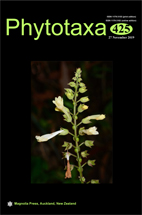Abstract
A new species, Bredia malipoensis D. H. Peng, S. Jin Zeng & Z. Y. Wen, from China, is described and illustrated here. Bredia malipoensis is morphologically similar to B. longiradiosa C. Chen in having cordate leaf blades, umbellate inflorescence and undulate petals with unguiculate bases and retuse apices. It is characterized by its terete stem and petioles, green calyx lobes, purple anthers, yellow connective appendages and white filaments. It is also morphologically similar to B. velutina Diels in having a woody stem, unequal and cordate leaf blades, but it is differentiated by having no reddish trichomes, larger and semiorbicular calyx lobes, and unguiculate petal bases. Bredia malipoensis differs markedly from the former relatives by its densely tomentose indumentum (with uniseriate non-glandular and sparse glandular trichomes) both on vegetative and floral parts, basal leaf venation and purplish-red petals. Our phylogenetic analyses using nuclear ribosomal ITS and chloroplast trnV-trnM regions strongly support the generic placement of B. malipoensis and its relatives B. longiradiosa and B. velutina within Bredia.

